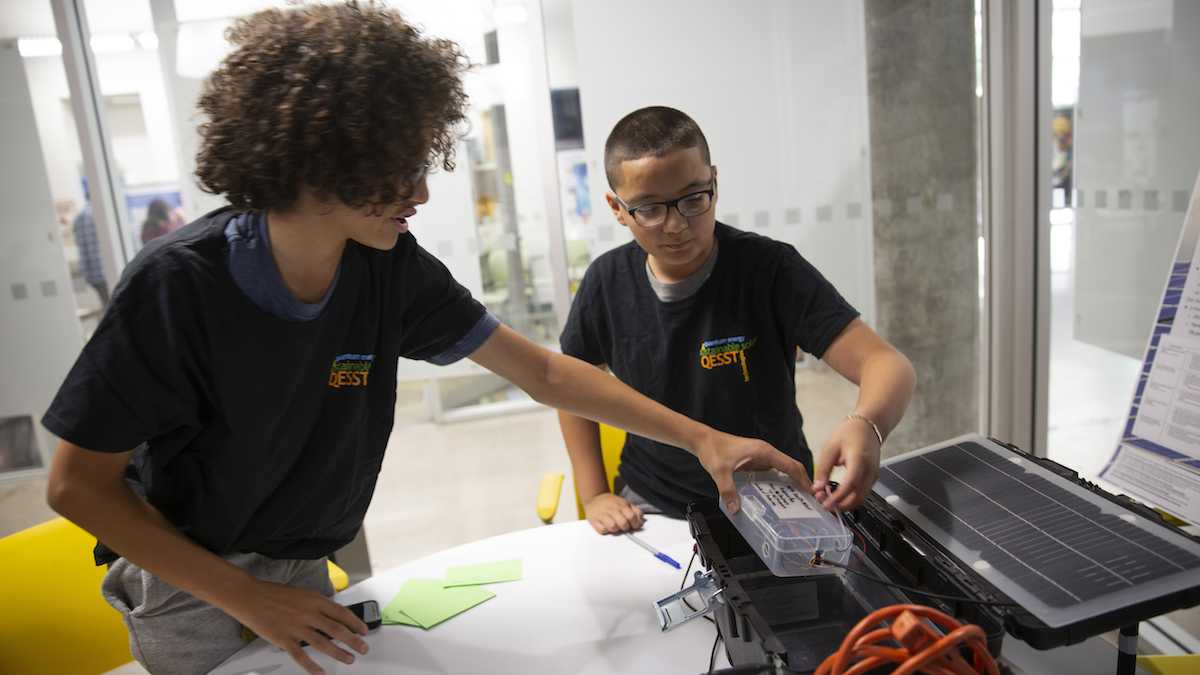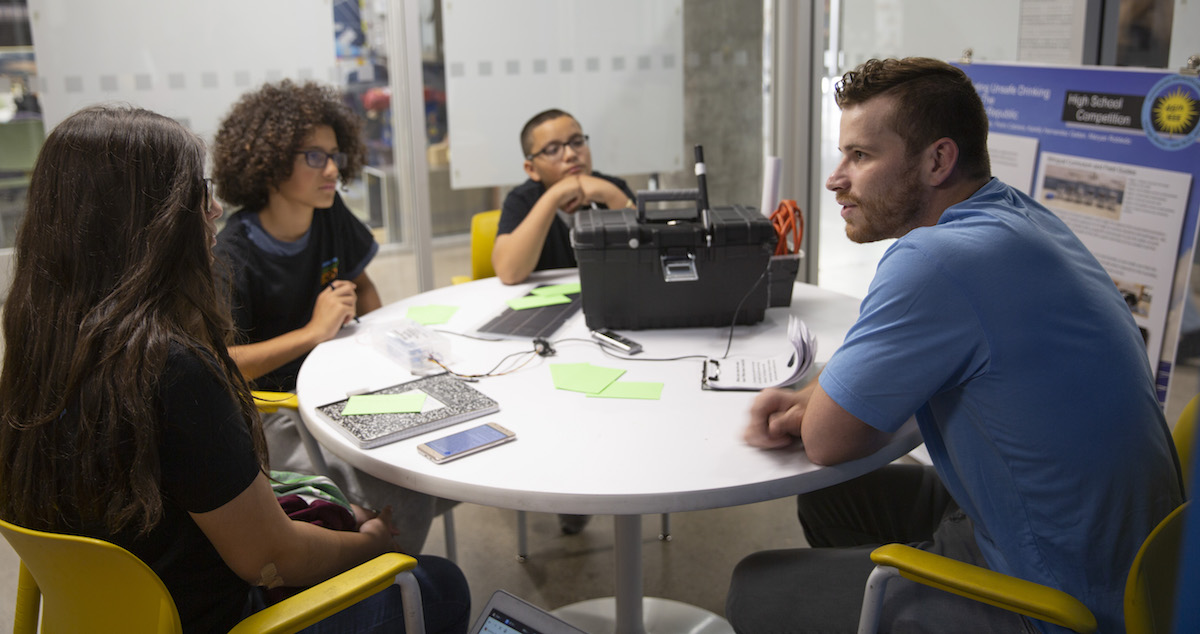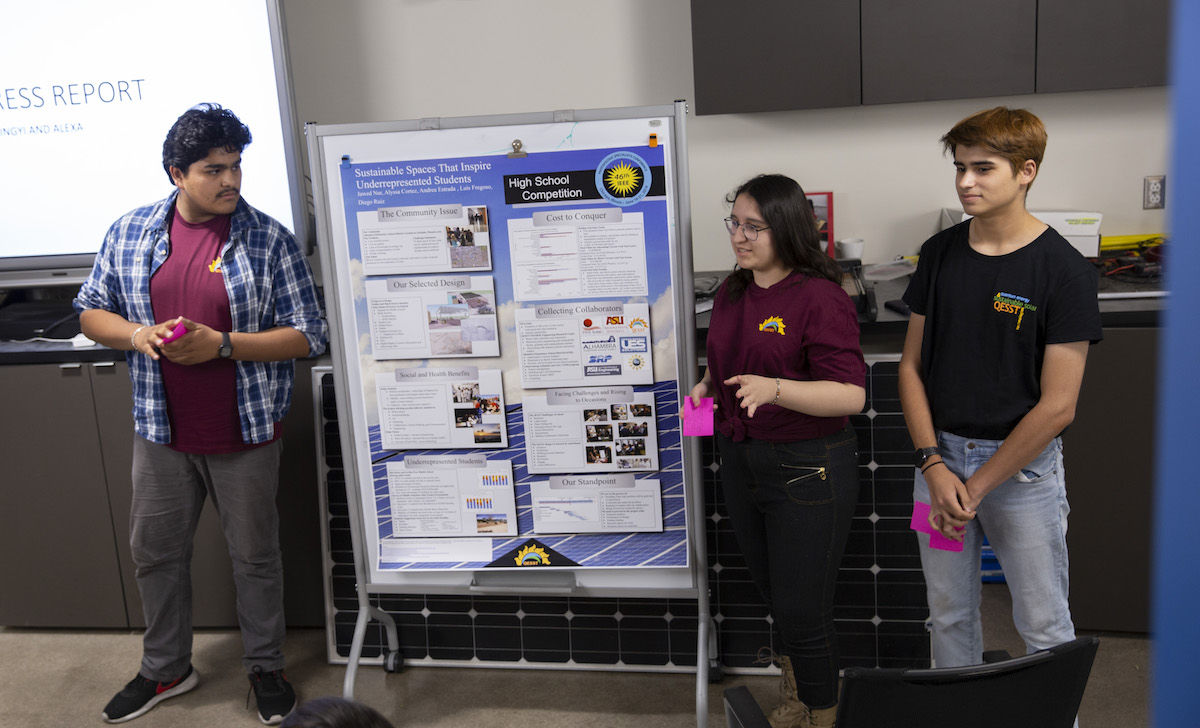
Lighting the way for future photovoltaics innovators

Above: At the 46th IEEE Photovoltaic Specialists Conference (PVSC) High School Competition, nine teams of high school students from Arizona and Indiana presented their solar energy projects. Victor Suarez-Gonzalez (right) spearheaded one of those projects, a clean drinking water project, after being inspired by the need for access to clean drinking water in many parts of the world. Photographer: Erika Gronek/ASU
This summer, nine teams of high school students from Arizona and Indiana traveled to Chicago to present their innovative solar energy projects at the 46th IEEE Photovoltaic Specialists Conference (PVSC) High School Competition.
The conference brings together leaders in photovoltaics from around the world to share photovoltaic-related innovations. This research forum strengthens collaborations, moves forward basic and applied photovoltaic science and engineering, and showcases the latest technical developments in photovoltaic characterization and manufacturing.
Each year, the conference hosts a high school solar project competition, giving solar energy researchers an opportunity to interact with the next generation of photovoltaic specialists.
Each team in this year’s competition developed a solar energy project working under the mentorship of a graduate student or post-doctoral researcher from Arizona State University, Purdue University or the University of New Mexico.
Mentors met with teams virtually or face-to-face throughout the school year to offer advice, feedback and encouragement on the projects, which ranged from modifying vertical solar energy farms to using solar energy to charge robot batteries.
Seven of the teams were sponsored by the Quantum Energy and Sustainable Solar Technologies Engineering Research Center. Based at ASU, QESST is jointly funded by the National Science Foundation and the Department of Energy. The eight-university consortium focuses on solving challenges to harnessing solar power in technologically effective and economically viable ways.
Michelle Jordan is the education director of QESST and an associate professor in the Mary Lou Fulton Teachers College at ASU. She was integral in organizing the high school competition at the IEEE Photovoltaic Specialists Conference, collaborating with Peter Bermel of Purdue, Silvana Ayala Pelez of the National Renewable Energy Laboratory and Sarah Kurtz of the University of California, Merced. Pelez and Kurtz are both members of QESST.
“Thanks to a generous grant from the NSF, 12 high school students from Arizona were able to travel to the conference to participate in person with their Chicago-area peers,” says Jordan. “These youth scholars were fully integrated into the conference experience, attending the opening keynote session and touring the exhibition hall before participating in the poster session alongside the adult presenters. Such cross-age events help create a sense of belonging for young aspiring engineers.”
For Alex Killam, an electrical engineering doctoral student in ASU’s Ira A. Fulton Schools of Engineering and one of the PVSC mentors, the opportunity to help inspire the future generation of engineers was rewarding.
“I kind of got into engineering from participating in programs similar to the PVSC competition. That’s what helped me out when I was in high school,” says Killam. “It’s important to pass that torch on to get more people involved. It’s great to get kids interested in STEM even if it’s not necessarily the exact area that they’re going to pursue later in life. But for them to get into a problem-solving mindset early on is important.”

Electrical engineering doctoral student Alex Killam (right) talks with members of the Combatting Unsafe Drinking Water in the Dominican Republic team during a mentoring session prior to the IEEE Photovoltaic Specialists Conference High School Competition. Photographer: Erika Gronek/ASU
Youth Scholar finds ways to promote clean energy and drinking water
One of the QESST-sponsored teams, comprised of students from Bioscience High School in Phoenix, was challenged to help combat unsafe drinking water in the Dominican Republic.
The engineering research project was spearheaded by 14-year-old Victor Suarez-Gonzalez who was inspired to help solve the problem of limited access to clean drinking water in many parts of the world.
After interviewing stakeholders in the Dominican Republic and conducting research to identify the root causes of the problem, Victor and his team found that despite access to clean and safe drinking water, some people who live in campos (fields) or in barrios in the Dominican Republic choose not to use available water filtration methods. This puts them in danger of contracting illnesses such as E. coli, salmonella and dysentery.
The team designed a mobile solar-powered curriculum designed to increase trust and decrease misunderstanding of water purification methods. Their solution uses a visual demonstration of the water purification process and a hands-on curriculum including a bilingual field guide, to explain each stage of purification.
“[Victor] started this project when he was in the sixth grade at Sevilla West Middle School,” says Mia DeLaRosa, facilitator for QESST’s Youth Scholar summer program and a teacher in the Alhambra Elementary School district.
“In school, Victor and his teammates were studying the Dominican Republic, where a lot of the area has inconsistent access to electrical power. In order for their project to be implemented and for their innovation to work, they realized they needed to incorporate solar technology,” she explains.
So Suarez-Gonzalez looked for a solution that could help address his clients’ water needs using a clean, reliable power source.

The prototype of a water filtration system created by Victor Suarez-Gonzalez and the team uses recycled plastic water bottles, coffee filters and a solar panel to power an Arduino, a turbidity sensor and UV light to remove bacteria and pathogens from drinking water. Photographer: Erika Gronek/ASU
The team built a bilingual field guide that can be displayed on a solar-powered tablet. The curriculum is accompanied by a prototype of a water filtration system that uses recycled plastic water bottles, coffee filters and a solar panel to power an Arduino, a turbidity sensor and UV light that removes bacteria and pathogens from drinking water.
The tablet contains a guide to demonstrate how the wate filtration system works, and has a microscope attached. The microscope helps users see the difference between the filtered and unfiltered water.
“We wanted the tablet to become solar powered because you can’t always find an outlet and you never know when the electricity will be turned on or off in the village, and it’s rarely available in the campos, so you really have to rely on different sources of power,” says Suarez-Gonzalez.
“We also make the claim that there are dangerous things in your water that you can’t see. But many people there don’t trust the available purification methods because of the difference in taste. We needed them to have visual evidence of our claims, so we needed to provide evidence backing our demonstration.”
The team won the $300 Social Impact Award at the PVSC competition.
“What inspired me to do this project is that I really wanted to help others and find out a way to do that,” Suarez-Gonzalez says. “I started researching more and then I just got really entangled in it and I really liked it.”
QESST continues to support such inspiring youth leaders who remain committed to developing their project.
The four team members participated alongside other high school students, local teachers, and undergraduate students from around the country in the QESST Youth Scholars summer bridge program.
Research by Jordan and her colleagues suggests that putting young students on the same level as their older peers is a powerful learning experience, especially when youngsters perceive that they are doing real work with real consequences for either their own or other communities. Jordan reports that all members of the summer cohort are intentionally positioned as learners and contributors.
Looking toward a sustainable future
A team of QESST Youth Scholars with students from four Phoenix-area high schools conceptualized a sustainable space — a solar-powered pavilion — to be constructed at their middle school alma mater in the Alhambra Elementary School District.
Mentored by industry experts and engineers from First Solar and Urban Energy Solutions, the QESST Youth Scholars partnered with graduate students in QESST and ASU’s Professional Science Master’s program in solar energy engineering and commercialization to create models, determine specifications and design building plans.
Once constructed, the pavilions will provide a gathering space on school grounds designed to display art, house a garden and charge electrical devices. The goal is to create an outdoor learning laboratory for teachers, students and the community — and to ultimately inspire underrepresented students to explore renewable energy.
This same QESST Youth Scholar team competed at PVSC in Hawaii last year, taking home the Best Business Innovation Award for designing a community solar co-op for the low-income neighborhood where the middle schools are located.
This year, after learning that policy and governance issues would likely inhibit implementation of the project, the team adapted their plans by designing the school solar pavilions and soliciting collaborators from a wide range of sources. The Solar Pavilion team remains committed to leading community energy engineering projects to make a positive difference in their community.

Members of the Sustainable Places that Inspire Underrepresented Students: Designing School Solar Pavilions team (left to right: Luis Fregoso, Alyssa Cortez and Jawed Nur) practice their presentation prior to the IEEE Photovoltaic Specialists Conference High School Competition. Photographer: Erika Gronek/ASU
“I hope to leave a pathway for others who are willing to take part and change their community, making it more environmentally friendly,” says team member Andrea Estrada. “I want organizations to listen to the innovative thoughts of young minds.”
Jessica Hauer, coordinator of energy efficiency and sustainability for the Alhambra Elementary School District, supports projects within the district that engage students in finding solutions for energy challenges.
“One of the reasons that I feel this project is so amazing for the youth who are pursuing solar pavilions for the Alhambra School district is because these high school students are role models for the current K-8 students within Alhambra,” says Hauer. “Research has shown that age proximity is important when students are looking for role models in the STEM field.”
Team member Alyssa Cortez will be a junior at Bioscience High School in the upcoming school year. She says she got involved in the project as a way to look to the future.
“When I was going into middle school, I didn’t really have much information about solar energy or how to protect the environment,” says Cortez. “Sustainability is very important because people don’t really think about the future. I feel like everything is basically about the now, rather than thinking about how our decisions now will affect us in the future.”
“It’s scary to think about how in 2050 the world might not be this way. It won’t be the same and it could be either worse or better depending on what we do now,” says Cortez.
Jordan looks forward to more opportunities to introduce high school students interested in developing solar energy solutions to high-caliber research experiences such as the PVSC high school competition.
Jordan and the education team at QESST plan to expand the program to more schools in the Phoenix metro area and around the country. Their goal is to broaden participation in engineering by providing equitable opportunities for historically underrepresented youth and their teachers so those groups can make real contributions to energy innovation.
Participating teams at the Photovoltaic Specialists Conference (PVSC) High School Competition
Augmenting Vertical Farming Using Solar Energy (Overall Champion, $800)
West Lafayette High School, West Lafayette, Indiana
David U. and Isani P.
Mentors: Muhammed Tahir Patel and Allison Perna, Purdue University
Combatting Unsafe Drinking Water in the Dominican Republic (Social Impact Award, $300)
Sevilla West Middle School, Phoenix, Arizona
Victor S., Pedro C., Karelly H. G. and Maryan R.
Teacher-Facilitator: Mia DeLaRosa
Mentor: Sebastian Husein, QESST graduate student, Arizona State University
Solar Can Solar Cells (Upcycle Award, $300)
Bioscience High School, Phoenix, Arizona
Jasmine M. C.
Teacher-Facilitator: Milton Johnson
Mentor: Emma Renteria, QESST postdoc, University of New Mexico
Using Solar Energy to Charge Robot Batteries (Solar Ambassadors Award, $300)
Bioscience High School, Phoenix, Arizona
Molly M., Johan A., Arick N., Osmar M., Alexis T., Maggie L. and Arturo G.
Teacher-Facilitators: Milton Johnson and Pope Enrique
Mentor: Alex Routhier, QESST graduate student, Arizona State University
Sustainable Places that Inspire Underrepresented Students: Designing School Solar Pavilions
QESST Youth Scholars, Phoenix, Arizona
Jawed N., Alyssa C., Andrea E., Luis F. and Diego R.
Teacher-Facilitators: Mia DeLaRosa and Michelle Jordan
Mentors: Alex Killam, Sunad Bhat and Karan Shah, graduate students, Arizona State University
Calibration of a Low-Cost Irradiance Detector and Comparison with Pyranometer
Bioscience High School, Phoenix, Arizona
Andrew V.
Teacher-Facilitator: Milton Johnston
Mentor: Joe Karas, QESST graduate student, Arizona State University
Solar Powered Mustang
Bioscience High School, Phoenix, Arizona
Ian W., Laura L., Andrew V. and Jimmy R.
Teacher-Facilitator: Milton Johnson
Mentor: Chinmay Vad, QESST graduate Student, Arizona State University, and Mathew Levar, Arizona Centers for Comprehensive Education and Life Skills (ACCEL)
Solar Powered Record Player
Northwestern High School, Kokomo Indiana
Rylund M., London S., Emily R. and Thomas W.
Teacher-Facilitator: Craig Williams
Mentor: Joseph Andler, Purdue University
S.E.E.D.: Solar Energy Enrichment Device
Bioscience High School, Phoenix, Arizona
Fabian C., Jimmy D., Victor G. and Angel V.
Teacher-Facilitator: Milton Johnson
Mentor: Nick Irvin, QESST graduate student, Arizona State University



































